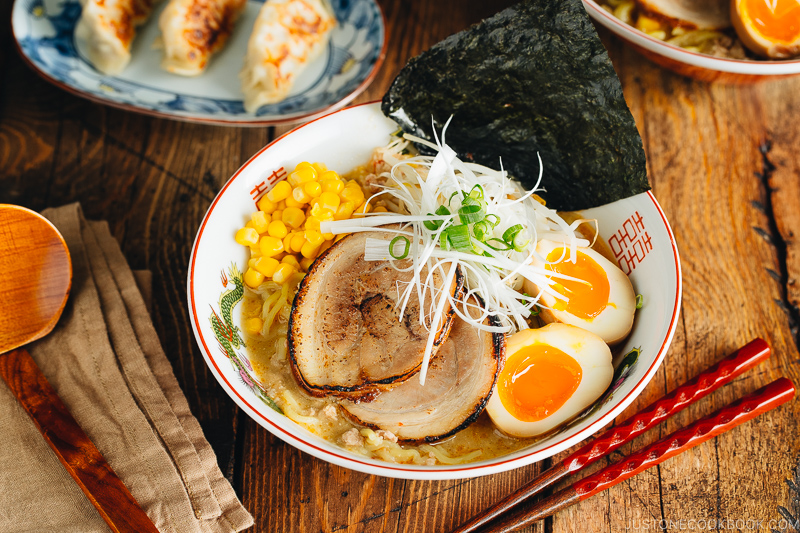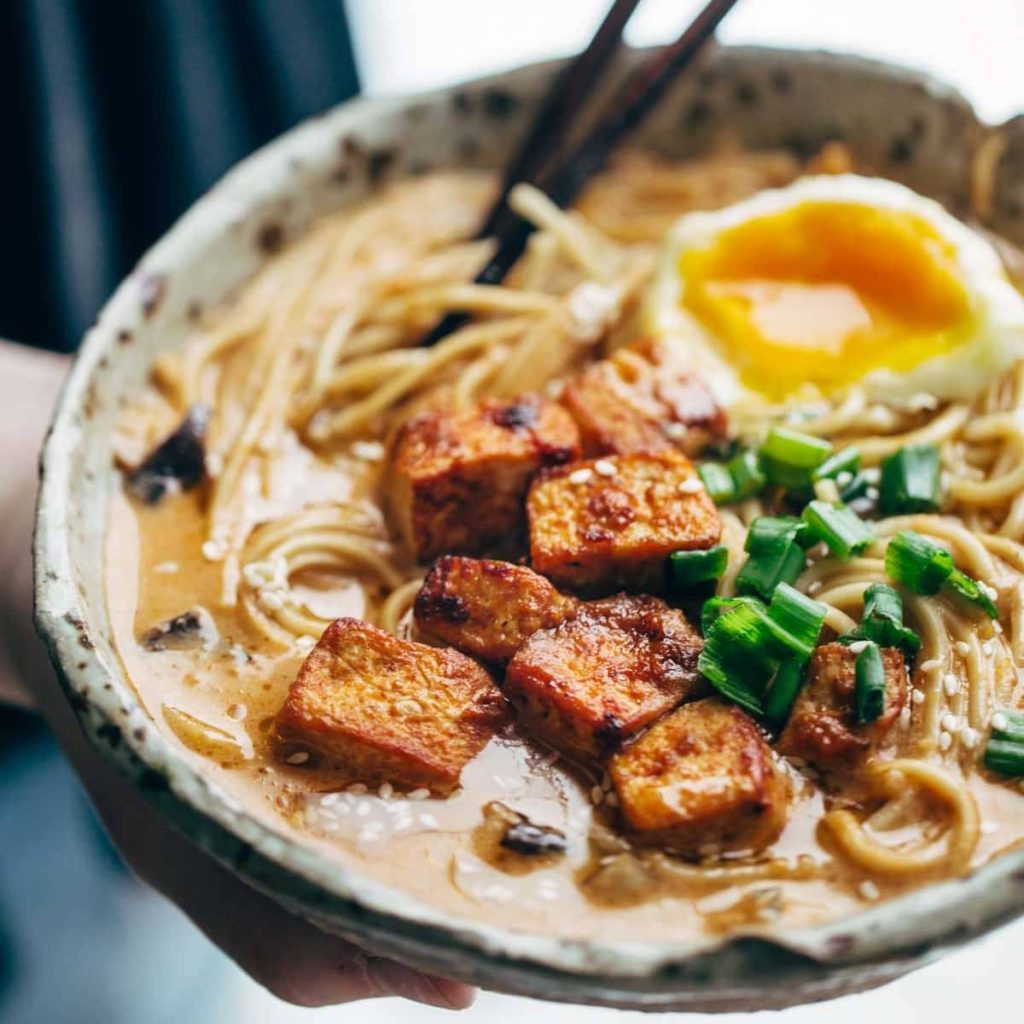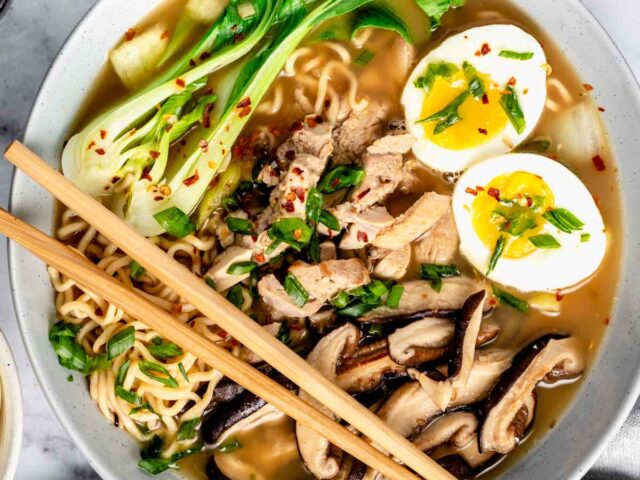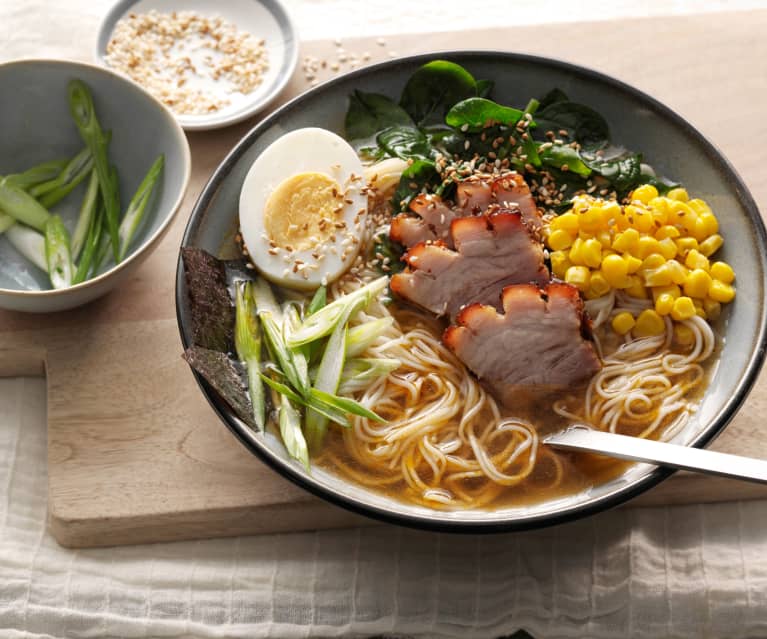Indulge in the rich and savory flavors of the Japanese Egg Tonkotsu Ramen. This delightful recipe features a creamy and flavorful tonkotsu broth, tender ramen noodles, marinated eggs, and an assortment of toppings. The key to the dish is the slow-cooked pork bone broth, which creates a velvety texture and robust taste. The marinated eggs add a deliciously creamy and savory element, while the toppings such as sliced pork, green onions, and nori seaweed complete the bowl. The Japanese Egg Tonkotsu Ramen is a comforting and satisfying meal that will transport you to the vibrant streets of Japan. Whether you’re a ramen aficionado or new to this classic dish, this recipe is sure to impress with its authentic flavors and irresistible appeal.

Japanese Egg Tonkotsu Ramen Recipe
Equipment
- 1 pan
Ingredients
- 1 tsp Chopped chives,
- 2 tbsp Butter
- 1 cup Tonkatsu broth
- Salt, to taste
- Black pepper, to taste
- 2 tsp Tamari paste
- 4 eggs
- 1 tbsp Mirin paste
- 1 tbsp Chopped garlic
- 4 packs Ramen noodles
Instructions
- Take a large pan.
- Add the butter and let it meltdown.
- Add in the eggs.
- Add in the tamari paste.
- Mix the tamari paste and eggs.
- Add the chopped garlic.
- Scramble the mixture.
- Add in the salt and pepper.
- Add in the tonkatsu broth and rest of the ingredients in the end.
- Mix all the ingredients well and then dish them out.
- Garnish the fresh chopped chives on top.
- Your dish is ready to be served.
Video
Notes
FAQs
Q1: Can I use a different type of protein instead of pork bones for the broth?
A: While pork bones are traditionally used to make tonkotsu broth, you can experiment with other proteins if you prefer. Chicken bones or a combination of pork and chicken bones can be used to create a flavorful broth. However, keep in mind that the taste and texture may vary from the traditional tonkotsu broth.
Q2: Can I make the tonkotsu broth in advance?
A: Yes, you can make the tonkotsu broth in advance. Once the broth is prepared and strained, allow it to cool completely before transferring it to an airtight container. Store it in the refrigerator for up to 3 days or freeze it for longer storage. When ready to use, gently reheat the broth on the stovetop before assembling your ramen bowls.

Q3: Can I use pre-packaged ramen noodles instead of making them from scratch?
A: Yes, you can use pre-packaged ramen noodles if you prefer a quicker and more convenient option. Look for fresh or dried ramen noodles in the Asian section of your local grocery store. Cook them according to the package instructions and proceed with the recipe as directed.
Q4: Can I adjust the thickness of the tonkotsu broth?
A: Yes, you can adjust the thickness of the tonkotsu broth according to your preference. If you prefer a thicker broth, you can simmer it for a longer duration to further reduce and concentrate the flavors. Alternatively, if you prefer a lighter consistency, you can dilute the broth with a bit of water or additional broth.
Q5: Can I make this recipe vegetarian or vegan?
A: While tonkotsu broth is traditionally made with pork bones, you can explore vegetarian or vegan alternatives. Consider using vegetable broth or mushroom broth as a base to create a vegetarian or vegan version of the ramen. Additionally, you can experiment with plant-based proteins or tofu as a substitute for the pork slices.
These FAQs should help address some common questions about Japanese Egg Tonkotsu Ramen. Feel free to experiment and make adjustments to suit your dietary preferences and taste. Enjoy the process of creating this flavorful and satisfying dish!
Cooking tips
Here are some helpful cooking tips to elevate your Japanese Egg Tonkotsu Ramen preparation:
1. Simmer the pork bones: To achieve a rich and creamy tonkotsu broth, it’s important to simmer the pork bones for an extended period of time. This slow cooking process allows the flavors to develop and the collagen from the bones to break down, resulting in a luscious and flavorful broth. Aim for a simmering time of at least 6-8 hours for the best results.
2. Skim off impurities: During the simmering process, impurities may rise to the surface of the broth. Use a skimmer or a spoon to carefully skim off any foam or scum that forms. This will help to ensure a clean and clear broth.
3. Add aromatics: Enhance the depth of flavor in your tonkotsu broth by adding aromatics such as sliced ginger, garlic cloves, and green onions. These aromatic ingredients infuse the broth with their delightful flavors, adding complexity to the overall dish.

4. Marinate the eggs overnight: For perfectly marinated eggs, allow them to sit in the soy-based marinade overnight. This extended marinating time allows the eggs to absorb the flavors fully, resulting in a deliciously seasoned and creamy yolk.
5. Blanch and shock the noodles: When cooking the ramen noodles, blanch them in boiling water until they reach your desired texture. To prevent them from becoming overly soft or mushy, immediately transfer the cooked noodles to a bowl of ice water to shock them. This stops the cooking process and helps to retain their firmness.
6. Customize the toppings: While marinated eggs are a traditional topping for tonkotsu ramen, feel free to get creative and add other toppings of your choice. Sliced pork belly, bamboo shoots, nori seaweed, and sliced green onions are popular options. You can also experiment with adding bean sprouts, corn kernels, or mushrooms for additional textures and flavors.
Remember, these cooking tips are meant to enhance your culinary experience and help you achieve the best results with your Japanese Egg Tonkotsu Ramen. Enjoy the process and savor the flavors as you create a bowl of this iconic and comforting dish.
Serving Suggestions
When it comes to serving Japanese Egg Tonkotsu Ramen, here are some delightful suggestions:
1. Traditional Presentation: Arrange the ramen in individual bowls, ensuring each bowl has a generous portion of noodles, slices of tender pork, and a halved marinated egg. Ladle the hot tonkotsu broth over the ingredients, allowing them to soak up the flavors. Garnish with chopped green onions, a sprinkle of sesame seeds, and a drizzle of chili oil for an added kick. Serve immediately while hot.
2. Family-Style Sharing: Serve the tonkotsu ramen in a large, decorative bowl and allow each person to assemble their own bowls. Place the cooked noodles, pork slices, marinated eggs, and various toppings such as sliced bamboo shoots, nori seaweed, and bean sprouts in separate bowls. Heat the tonkotsu broth and keep it warm in a pot or a slow cooker. Each person can then customize their bowl by adding their preferred ingredients and pouring the hot broth over them. It creates an interactive and customizable dining experience.

3. Extra Toppings and Condiments: Offer a variety of additional toppings and condiments on the side for individuals to enhance their ramen according to their taste. Some popular options include pickled ginger, shredded cabbage, garlic chips, corn kernels, and sesame seeds. Soy sauce, chili oil, and sesame oil can be provided as condiments for people to adjust the flavor to their liking.
4. Side Dishes: Serve some traditional Japanese side dishes alongside the ramen to complement the meal. Miso soup, Japanese-style cucumber salad, or a plate of gyoza (dumplings) make excellent accompaniments. These side dishes add variety to the meal and provide additional flavors and textures.
Remember to provide chopsticks, spoons, and small plates for easy eating and sharing. Encourage your guests to savor the different elements of the dish and enjoy the robust flavors of the tonkotsu broth. With these serving suggestions, you can create an enticing and satisfying ramen experience for yourself and your guests.








